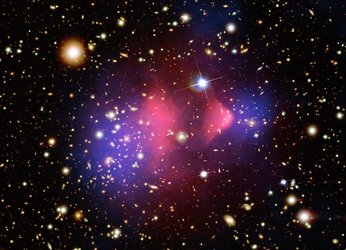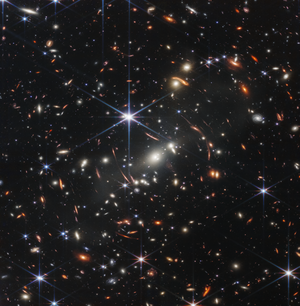

Bullet Cluster (NIRCam Image)
All galaxies are made up of stars, gas, dust, and dark matter, which are bound together by gravity. The Bullet Cluster is made up of two very massive collections of galaxies, known as galaxy clusters, that are themselves bound by gravity. This cluster is found in the Carina constellation 3.8 billion light-years from Earth.
The NASA/ESA/CSA James Webb Space Telescope captured the central region of the Bullet Cluster with its NIRCam (Near-Infrared Camera). The scene contains two massive galaxy clusters that sit on either side of the large, light blue spiral galaxy at the center. Webb’s extremely precise images revealed many more distant galaxies and faint objects, allowing a research team to refine the amount of mass in the two galaxy clusters.
The team measured thousands of galaxies in Webb’s images to accurately “weigh” both the visible and invisible mass in these galaxy clusters. They also carefully mapped and measured the collective light emitted by stars that are no longer bound to individual galaxies — known as intracluster stars. The team confirmed that the intracluster light can be a reliable tracer of dark matter, even in a highly dynamic environment like the Bullet Cluster. If these stars are not bound to galaxies, but to the cluster’s dark matter, it might become easier to pin down more specifics about the invisible matter. The researchers’ new measurements significantly refine what we know about how mass is spread throughout the Bullet Cluster. The galaxy cluster on the left has an asymmetric, elongated area of mass along the left edge of the blue region, which is a clue pointing to previous mergers in that cluster.
This image spans roughly 6.3 million light-years across. It was created with Webb data captured on 20 January 2025 from proposal #4598 (PI: M. Bradac). Several filters were used to sample specific wavelength ranges. The color results from assigning different hues (colors) to each monochromatic (grayscale) image associated with an individual filter. In this case, the assigned colors are: Blue: F090W, Cyan: F115W, Green: F150W, Yellow: F200W, Yellow: F277W, Orange: F356W, Red: F410M, Red: F444W
The results have been published in The Astrophysical Journal Letters.
[Image description: Webb observation of the Bullet Cluster shows many overlapping objects, including foreground stars, galaxies in galaxy clusters, and distorted background galaxies behind the galaxy clusters, set against the black background of space.]





